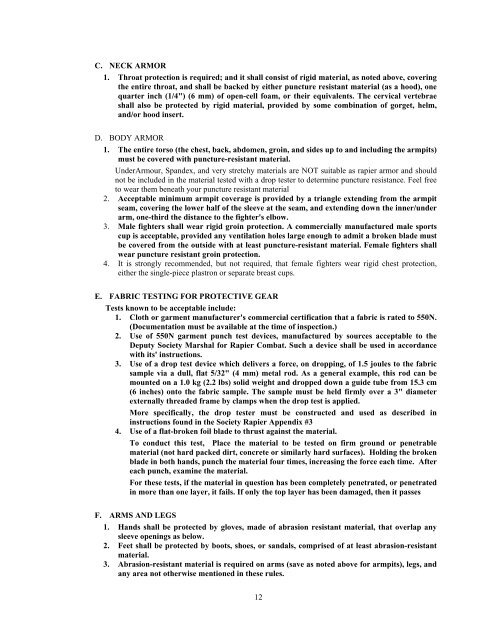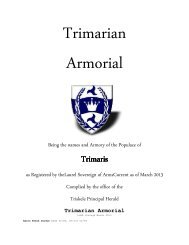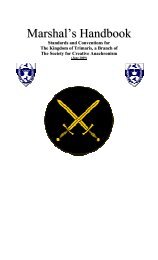Trimarian Rapier Rules - Kingdom of Trimaris
Trimarian Rapier Rules - Kingdom of Trimaris
Trimarian Rapier Rules - Kingdom of Trimaris
You also want an ePaper? Increase the reach of your titles
YUMPU automatically turns print PDFs into web optimized ePapers that Google loves.
C. NECK ARMOR<br />
1. Throat protection is required; and it shall consist <strong>of</strong> rigid material, as noted above, covering<br />
the entire throat, and shall be backed by either puncture resistant material (as a hood), one<br />
quarter inch (1/4") (6 mm) <strong>of</strong> open-cell foam, or their equivalents. The cervical vertebrae<br />
shall also be protected by rigid material, provided by some combination <strong>of</strong> gorget, helm,<br />
and/or hood insert.<br />
D. BODY ARMOR<br />
1. The entire torso (the chest, back, abdomen, groin, and sides up to and including the armpits)<br />
must be covered with puncture-resistant material.<br />
UnderArmour, Spandex, and very stretchy materials are NOT suitable as rapier armor and should<br />
not be included in the material tested with a drop tester to determine puncture resistance. Feel free<br />
to wear them beneath your puncture resistant material<br />
2. Acceptable minimum armpit coverage is provided by a triangle extending from the armpit<br />
seam, covering the lower half <strong>of</strong> the sleeve at the seam, and extending down the inner/under<br />
arm, one-third the distance to the fighter's elbow.<br />
3. Male fighters shall wear rigid groin protection. A commercially manufactured male sports<br />
cup is acceptable, provided any ventilation holes large enough to admit a broken blade must<br />
be covered from the outside with at least puncture-resistant material. Female fighters shall<br />
wear puncture resistant groin protection.<br />
4. It is strongly recommended, but not required, that female fighters wear rigid chest protection,<br />
either the single-piece plastron or separate breast cups.<br />
E. FABRIC TESTING FOR PROTECTIVE GEAR<br />
Tests known to be acceptable include:<br />
1. Cloth or garment manufacturer's commercial certification that a fabric is rated to 550N.<br />
(Documentation must be available at the time <strong>of</strong> inspection.)<br />
2. Use <strong>of</strong> 550N garment punch test devices, manufactured by sources acceptable to the<br />
Deputy Society Marshal for <strong>Rapier</strong> Combat. Such a device shall be used in accordance<br />
with its' instructions.<br />
3. Use <strong>of</strong> a drop test device which delivers a force, on dropping, <strong>of</strong> 1.5 joules to the fabric<br />
sample via a dull, flat 5/32" (4 mm) metal rod. As a general example, this rod can be<br />
mounted on a 1.0 kg (2.2 lbs) solid weight and dropped down a guide tube from 15.3 cm<br />
(6 inches) onto the fabric sample. The sample must be held firmly over a 3" diameter<br />
externally threaded frame by clamps when the drop test is applied.<br />
More specifically, the drop tester must be constructed and used as described in<br />
instructions found in the Society <strong>Rapier</strong> Appendix #3<br />
4. Use <strong>of</strong> a flat-broken foil blade to thrust against the material.<br />
To conduct this test, Place the material to be tested on firm ground or penetrable<br />
material (not hard packed dirt, concrete or similarly hard surfaces). Holding the broken<br />
blade in both hands, punch the material four times, increasing the force each time. After<br />
each punch, examine the material.<br />
For these tests, if the material in question has been completely penetrated, or penetrated<br />
in more than one layer, it fails. If only the top layer has been damaged, then it passes<br />
F. ARMS AND LEGS<br />
1. Hands shall be protected by gloves, made <strong>of</strong> abrasion resistant material, that overlap any<br />
sleeve openings as below.<br />
2. Feet shall be protected by boots, shoes, or sandals, comprised <strong>of</strong> at least abrasion-resistant<br />
material.<br />
3. Abrasion-resistant material is required on arms (save as noted above for armpits), legs, and<br />
any area not otherwise mentioned in these rules.<br />
12




